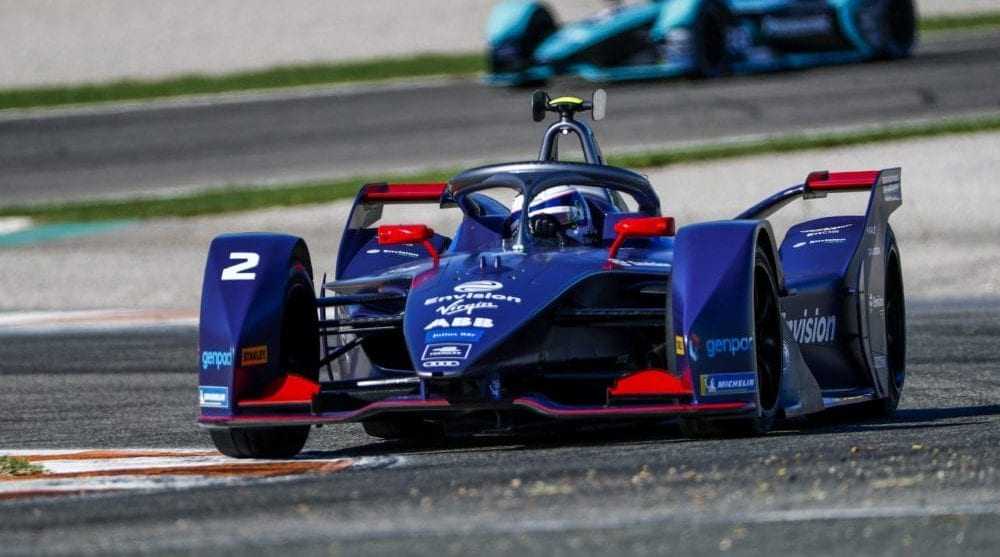Key Takeaway: Formula E, the electric car racing series, serves as an incubator for the world’s biggest car companies’ EV aspirations. The companies test their latest work at Ricardo Tormo raceway in Spain.
An alien sound echoes down the valley in Spain, a soaring note that punches the air as it whizzes past before collapsing into a hiss.
It’s a sound investors should pay attention to. It belongs to a Formula E car – and offers clues as to how the car industry’s biggest players are planning the next generation of electric vehicles.
The Ricardo Tormo circuit lies 12 miles outside Valencia, where these futuristic creations, their bodies more akin to jet fighters than road cars, hurtle around the track out of public view for pre-season testing. Along the pit lane the teams operate in near-silent efficiency, mechanics preparing for tire changes, drivers waiting for the signal to launch, engineers with laptops open and eyes glued to an array of data. Their cars go from zero to 60 MPH in 2.8 seconds, with a top speed of 174 MPH. It is the fastest R&D lab in the world.
Formula E was scoffed at when introduced in 2014: a motor racing championship dedicated to electric cars, competing at the highest level in cities around the world, with sustainability as its core tenet. But it’s catching on, as revenues rise annually (it’s profits are about the same as its carbon output).
To supporters, the fact that it’s a bit player compared to Formula 1 and NASCAR is besides the point. Formula E’s focus is elsewhere.
“We expect this championship to become the framework for research and development around the electric car,” Formula E Holdings Chairman Alejandro Agag said when the sport began, promising an alternate route to success.
So it has proven. Five seasons ago, the teams were limited to 133kW of power and had to use two cars per driver: a single battery didn’t have the range to finish a race. Today teams use a single car for the full distance (races are 50-62 miles, around a 1-2 mile track according to sponsor Julius Baer) and run at 250kW, recharging the lithium–ion battery at the end of a race in less than 45 minutes. The next generation of cars will be even better, perhaps doubling available horsepower.
“When we began we had a battery capacity of 28kW per hour,” recalls Sylvain Filippi, managing director of Envision Virgin Racing. “Today we have 52kW in pretty much the same volume, if not a bit smaller, with hardly any weight increase. We’re basically doubling the amount of energy density in four years.”
The need to innovate in sports, Filippi told Karma, means that Formula E can push boundaries the car industry can’t reach on their own. Today’s road cars contain several modifications that first emerged during motor races, from anti-lock braking systems and all-wheel drive down to carbon fibe chassis and rear-view mirrors. Formula E is still looking for its own flagship innovation, but it’s still paved the way for road cars to push beyond their current batteries, which are typically around 350V.
“We expect this championship to become the framework for research and development around the electric car.”
“Car manufacturers don’t all develop products themselves, there’s a supply chain,” Filippi says. “Six or seven years ago, if you wanted to produce a high voltage inverter for a car, say 800V or more, you just couldn’t find it. Now you have six, seven, eight major suppliers that have developed very reliable 800–900V systems. And that’s a direct benefit” of Formula E.
Formula E has attracted teams from the biggest names in the motor industry, such as Audi, BMW, Jaguar and Nissan. The latest giants to join the paddock are Mercedes-Benz and Porsche.
“It’s part of our strategy to 2025,” Pascal Zurlinden, Porsche’s director of GT factory motorsport, told Karma. “For us, this is an information laboratory, where you have as much exchange between engines and engineering as you can.”
Porsche’s entered Formula E racing earlier this year, and recently started selling its electric road car, the Taycan. “We’re sharing some technology,” Zurlinden said.
Despite support from the car industry, challenges remain for the sport to deliver. Electric cars haven’t got the range of gas-powered racers and they take longer to refill. Their batteries are reliant on lithium – an element with a finite supply on Earth. Concerns about where charge points will be located, how such networks will be powered and the role of AI driving have been raised.
Participants are confident the sport has a future. The paddock is alive with talk of introducing wireless inductive charging for vehicles, in the same way some cell phones can be charged. Others look at plans for the vehicles to have the same range as gasoline-fueled cars, with the ability to recharge the battery to 80% within a quarter of an hour. And a spin-off series, Roborace, is already pitting electric driverless cars against each other.
“There’s a lot of challenges in front of us,” Zurlinden concedes. “But [electric cars] are developing really quickly compared with standard engines … and the electric motor here is using technology that will come to road cars.”
Formula E is moving fast in every way imaginable – and it’s bringing the cutting edge of electric vehicle design with it.






















